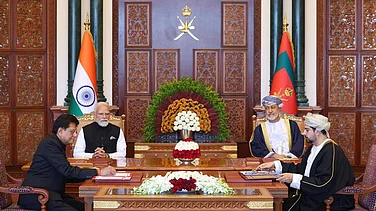India, which had once claimed to ‘feed the world', seems to be taking a U-turn from its earlier position.
In April, Prime Minister Narendra Modi, during his talks with US President Joe Biden, had offered to supply India's food stock to the world if the World Trade Organisation permitted.
"We already have enough food for our people but our farmers seem to have made arrangements to feed the world. So I don't know when WTO will give permission and we can supply food to the world," he had said.
But since May, the government seems to be banning the exports of several commodities, including wheat and sugar to control food inflation and to ensure availability in the domestic market.
Last Saturday, the government announced a ban on exports of wheat flour, maida, semolina, and wholemeal atta to curb rising prices.
Now, as per reports, the government is considering restrictions on the exports of rice.
Is There A Food Crisis In The World?
Global wheat prices have risen by more than 40 per cent since the beginning of the year due to the Russian invasion of Ukraine.
The commodity prices in the international market were already at a 10-year high before the Russia-Ukraine war. The war and the consequent sanctions on Russia have disrupted the food supply chain, thus increasing the demand for Indian wheat.
Both Russia and Ukraine are the major exporters of wheat, accounting for around one-fourth of the global wheat trade. Before the war, Ukraine and Russia accounted for a third of global wheat and barley exports.
In April, India had hoped to fill the market gap and said that it was looking to export a record one crore tonnes of wheat in 2022-23. This provided some support to global prices and kept at bay fears of major shortages.
Why India Is Putting Restrictions On Commodities Export?
While PM Modi claimed to feed the world, India is struggling to keep the food inflation down at home. India is the second-biggest producer of wheat and rice. In May, India banned the export of wheat after heatwaves curtailed output and domestic prices rose to a record high.
The all-India average retail price of wheat has risen by over 22 per cent to Rs 31.04 per kg as on August 22, compared to Rs 25.41 per kg in the year-ago period, according to consumer affairs ministry data.
The ban led to an increased demand for wheat flour, with its exports rising 200% between April and July from a year ago, the government had said.
Meanwhile, the average retail price of wheat flour (atta) has increased by over 17 per cent to Rs 35.17 per kg as against Rs 30.04 earlier, as per govt data.
As on 22 July, India had 27.8 million tonnes of wheat in public stocks against the stocking norm of 27.6 million tonnes, slightly above what it requires for the food subsidy schemes and strategic reserves.
The government had estimated that production would hit an all-time high of 111.32 million tonnes. However, wheat prices in both wholesale and retail markets have also come under pressure due to a nearly 3 per cent drop in the domestic output to 106.84 million tonnes in the 2021-22 crop year.
Commerce Secretary BVR Subrahmanyam said some parts in the country have seen prices of wheat and flour jump 20 to 40 per cent in recent weeks. Because of the sharp rise in global prices, some farmers were selling to traders and not to the government.
"We don't want the wheat to go in an unregulated manner where (wheat) may either get hoarded and is not used for the purpose which we are hoping it will be used for -- which is serving the food requirements of vulnerable nations and vulnerable people," Subrahmanyam had said.
How Heat Waves Affected India’s Wheat Output
Earlier this year, heat waves in several wheat-growing regions in India affected wheat crops. This is likely to bring the production of wheat during 2021-22 down to 106.84 million tonnes, as against the earlier estimate of 111 million tonnes, as per the fourth advance estimate by the Union Ministry of Agriculture and Farmers Welfare.
While banning the export of wheat, the government had stated it aimed to manage the overall food security of the country.
During the recent Parliament session, the government said that there was no shortage of wheat stock in the central pool.
In a written reply to Lok Sabha during the recent Parliament session, Union Agriculture Minister Narendra Singh Tomar said: “As on 01.07.2022, the actual stock of wheat is 285.10 Lakh Metric Tons (LMT) against the Buffer norm of 275.80 LMT.”
Is India Looking To Import Wheat?
Earlier this month, Reuters reported that India could cut a 40 per cent duty on wheat imports to rein in the rising domestic prices of the crop.
There were reports stating India is likely to import wheat but the government maintains that the wheat situation is under control.
The Department of Food & Public Distribution said there are no plans for that as it has ample stocks to meet the domestic requirements and FCI has enough stock for public distribution.






























